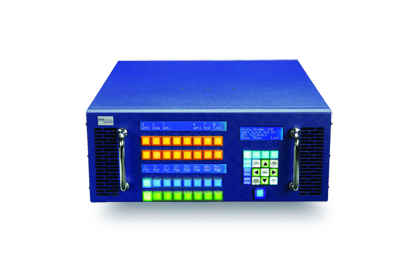
Vista Spyder X2 Video Processor
What would the cable industry be if it weren’t for screens? They display the content we create for TV and deliver the visuals for everything our broadband networks offer. Screens played an especially big role in this year’s The Cable Show. One popular demonstration on the show floor featured huge (and gorgeous) 80 inch 4K TVs - so named because of their ability to display 4,000 lines of resolution. This is impressive, especially when compared to today’s HDTV’s, which show about 1,000 lines. Remarkable screens continued inside The Observatory, the industry exhibit at the center of the show floor. Visitors were greeted by huge video and images on an all-encompassing custom curved 270-degree screen. But the screen that really took The Cable Show to a whole new level was the monster 72-foot backdrop screen behind the General Session stage. Projection screens like that are most often used for live sporting arenas, operation control centers, and broadcast news stations, but we put it to good use displaying everything from multi-media keynote addresses to cutting-edge tech demonstrations. We think the tech and specs behind this system are really impressive, and with the show over, well worth a second look. Just check out what was needed to build and manage the system used in the 72-foot General Session screen:
- 1 Projection Screen. The projection screen itself was a custom-made Stewart Fixed Screen made by Stewart Filmscreen Corporation. These screens are made with seamless aluminum tubing and special “S” hooks to secure the edges and keep it taught. The projection screen was 72 feet wide and 18 feet high!
- 1 Video Processor and Presentation Switcher. The processor used for the big screen was the Spyder X20 package made by Vista Systems. This device converts and routes any signal to any combination of display devices (or projectors, in our case). Each X20 is capable of processing an amazing 20 megapixels at 50-60 frames per second. The Spyder X20 is also capable of 16 video layers of unrestricted blending, windowing, and scaling of video and images. If you can imagine it, these processors can create it.
- 6 projectors. The Spyder video processor receives the content and routes to the projectors. To create the blend of images and videos on the 72-foot screen, three projectors were used. Three projectors were also reserved as backup. In terms of light output, the projectors were pushing out an impressive 20,000 lumens.
- 300 amps of power. The system used 200 amps per phase to power the projector and 100 amps per phase for the production, camera power and playback needs.
- Labor. In total, one video engineer, one Spyder operator and one lead projectionist were needed to operate the projection system. There was also an army of video producers, graphic designers and writers who created the magic that was projected onto the screen.
It seems fitting that an industry built to help consumers get the most out of their screens utilized one of the biggest and most impressive available to tell our story at this year’s The Cable Show.